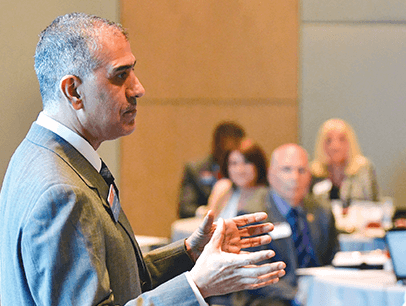Kumar Parakala, president of GHD Digital, an Australian-based professional services company, was quick to see the tip of the communication iceberg when the COVID-19 pandemic appeared in March 2020.
He realized that the stress and uncertainty of the crisis—coupled with employees who were suddenly working from home—was going to require a new level of connection. In a blog post for Forbes magazine, Parakala described how his company moved quickly to enhance traditional communications. Teams began to converse more through additional weekly meetings, frequent newsletters, town hall gatherings, one-on-one conversations with employees, and even personalized handwritten letters to keep workers connected and engaged.
“During difficult times, increasing the flow of information helps convey that you care for your people and are available to answer any questions,” Parakala noted. “I’ve found this also significantly reduces misinformation and confusion and brings leaders much closer to their employees.”
Parakala intends to keep up the new level of communication, even when the pandemic is no longer a critical business and humanitarian concern. It’s just one of the lessons he’s learned. As difficult as the crisis has been for leaders like him, it has offered a rare opportunity to do away with old ways of thinking and reinvent leadership from the ground up. There are new opportunities to seek and act on innovative ideas from non-traditional sources, such as younger, diverse workers who bring less experience but more relevant insight to the table. Businesses will need quick responses and quicker pivots when called for. Experts say it’s now more important than ever for companies to live by their mission and values, and continually share how each employee contributes to that effort.
Uncertainty is our new common challenge.
These realities will require the post-pandemic leader to broaden and hone the skills needed to adapt and succeed. Many of these capabilities have nothing to do with the top-down model of the past and everything to do with demonstrating empathy and connection, modeling resilience and transparency, and inspiring trust among workers.
“We are seeing new types of problems emerge. And as leaders, we need to be careful that we are not evaluating new challenges and opportunities using our old paradigms and criteria,” Parakala says.
Uncertainty is our new common challenge. Stefanie Johnson, associate professor of organizational leadership and information analytics at the University of Colorado Boulder, says the past two years brought business leaders face to face with uncertainty—and those who adapted best and most quickly are those who have had the most success. Going forward, the skills that will differentiate successful leaders are skills built around managing uncertainty.
“The new definition of normal is that we need to expect a lot of transition and flexibility,” she says.
Here’s a closer look at five traits that signify resilience and opportunity for leaders in a business world that has changed drastically.
Trust
Arguably the biggest workplace change brought about by the pandemic is the widespread adoption of remote work. A Pew Research study found that a majority of employed adults in the U.S. whose jobs can be done from home are now working from home all of the time, some of the time, or most of the time—and 62% of those respondents rarely or never worked from home prior to the coronavirus outbreak. It’s a change played out across the globe, and one that won’t be going away any time soon.
Numerous studies show that employees who can work from home now vastly prefer doing so, and leaders are experimenting with a variety of work models ranging from hybrid schedules to fully remote. It’s a new frontier that perfectly illustrates the role trust now plays in leader-employee relationships.
In challenging times, leaders need to be authentic in their communication.
“If you don’t trust people to do their job, you’re not going to be able to function,” says Johnson. “You’re going to need to trust your team members to work on their own.”
When workers feel trusted by their leaders, they do better work, collaborate more, feel more engaged, and stay at their jobs longer. Some leaders may have had concerns about remote work at the beginning of the pandemic, but studies show that employees who are able to work remotely tend to work longer hours and perform their jobs just as well as those who are in the office.
Trust has a critical flipside as well, notes Jandel Allen-Davis, president and CEO of Craig Hospital in Denver, Colorado. “As important as it is for leaders to trust their teams, it’s equally important for teams to have trust in leadership,” she says. “In a time like the one we’re going through now, when there’s so much to react to, it’s important for leaders to guide their ship with a steady hand, knowing when to react to the news of the day and when to stay the course.”

Communication
With their workforces scattered, remote, and often distracted or disappointed by the latest news, smart leaders know it’s more important than ever to maintain active communication with their teams, and to make sure team members actively communicate with one another.
Workplace disruption has also led leaders to realize the basic details about issues are often not enough—employees want to understand the “why” behind specific actions and decisions.
“We have had to both interpret and establish the context moment-to-moment since March 2020,” Allen-Davis says. “If you take the time to establish the context, you’re going to get more people on board with you. If people understand how they fit into the picture and what the rationale is for going a certain direction, they’re less likely to panic or be reactive. And they’re also more likely to follow you as you figure out what’s got to be done.”
In challenging times, leaders need to be authentic in their communication, experts say—to be clear and direct—and when appropriate, to admit they don’t have all the answers or are waiting for more information to make a decision.
It’s also key to add positivity to your communications mix, recognizing employees for a job well done or expressing gratitude for how hard they’re working. For example, a leader reaching out personally to a team member to thank them, or just to ask how they’re doing, with no work agenda attached, can mean the world.
And while technology has made face-to-face communication possible during the pandemic, leaders need to be careful not to overuse the virtual tools, Parakala says.
“You need to be conscious that people may want a personal break,” he says. “Just because Zoom is available 24-7 doesn’t mean we have to use it.”

Empathy
The pandemic fundamentally changed the relationship between leaders and their teams. Interacting with workers over Zoom—where pets or children might be seen or heard—and helping them cope with stress and burnout have made it clear that leaders will need to operate with increased empathy in the post-pandemic world.
The health crisis elevated levels of stress, anxiety, and depression, causing employers to add mental health benefits and pay attention to employee well-being in a way they never have before. Leaders can no longer view all employees as the same, says Johnson, the Boulder leadership professor. Workers are individuals with unique needs, struggles—and strengths.
When workers feel trusted by their leaders, they do better work, feel more engaged, and stay at their jobs longer.
“It’s about being better able to listen to people and understand their perspective,” she says of post-pandemic leadership. “Leaders are there to create an environment where their team members can be successful.”
Terri Egan, associate professor emeritus of applied behavioral science at Pepperdine University in Malibu, California, believes the new emphasis on workplace empathy also will require leaders to be more flexible with employees about schedules and assignments.
“[Leaders] have to understand that people are going through a lot of changes still, and that what they see on the surface is just a peek into what’s really happening in the lives of their employees,” Egan says.
Culture
The pandemic has reshaped the dynamics of the workplace too. Time away from the office, in the midst of a worldwide crisis, has given many workers a new sense of what is really important in their lives. A racial reckoning that exploded alongside the pandemic has sharpened the focus on issues of diversity and equity. And a worldwide labor shortage has made it more important than ever for leaders to give their teams a sense of purpose.
“As employers, we talk the game of really caring about our employees through the mind-body-spirit perspective,” says Allen-Davis, the hospital CEO. “But in a labor shortage, we need to be able to recruit—and more importantly, retain—a highly skilled workforce who comes to work and feels like, This is where I want to be. This is worth getting up out of out of bed in the morning and coming to work for.”
Parakala has seen the change, especially with a younger workforce who want jobs where they can make a difference. His company has shifted recruiting efforts to focus on company culture, not salaries.
“We have people who are probably getting offered double the money that we are willing to pay, but they want to come and work in our teams because they like the culture and like the purpose,” he says. “They like the empathy; they like the way we engage with them. They like our transparency. We are seeing a highly visible trend where if that higher purpose is clearly articulated, it is a motivator for a lot of people to seriously consider when making employment choices.”
Humanity
COVID-19 has changed leadership in innumerable ways, but in the end, the biggest lesson for leaders has been the importance of connecting with workers on a human level, Parakala says. It’s about prioritizing their health and safety. It’s about reaching out in ways you haven’t before, and about keeping your door open at all times.
“We need to get out and connect with our people in the organization as if we are connecting with our own family members,” Parakala says. “When we talk to our family members, we are generally very open, very empathetic, very caring. The same mindset needs to be applied for people in your organization.
“Every one of those individuals, no matter how senior they are, are all fighting their own battles,” he continues. “Being able to understand that and have that emotional connection—to have a conversation that is not just business—is going to be very important to earn trust as we move forward.”
Watch Past International President Mohammed Murad from his 2018 Annual Convention session where he poses the question, is leadership for me? Find out how to answer this as he takes you through his 5 H’s of leadership: Head, Heart, Health, Humility and Happiness.
Greg Glasgow is a Denver-based author and freelance writer and a frequent contributor to the Toastmaster. His debut nonfiction book, Disneyland on the Mountain: Walt, the Environmentalists, and the Ski Resort That Never Was, was published in September 2023.
Related Articles

Personal Growth
Emotional Intelligence: The Other Kind Of Smart

Leadership
Is Leadership for Me?

Leadership



 Previous
Previous

 Previous Article
Previous Article